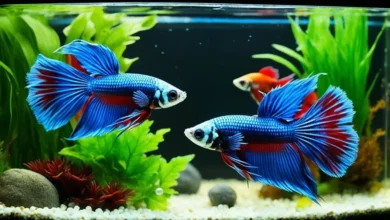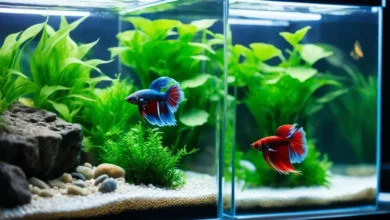
Are you a betta fish breeder looking to enhance your breeding skills and achieve better results? Have you considered keeping a breeding betta fish journal to log your experiences?
A breeding betta fish journal is not just a notebook, but a powerful tool that can take your breeding endeavors to the next level. It allows you to document and track all the important details, observations, and milestones throughout the entire breeding process. But why is it so important to log your experiences? And how can a breeding journal help you improve your breeding skills and outcomes?
Why Start a Breeding Betta Fish Journal
Documenting your betta breeding adventures through a breeding betta fish journal can provide numerous benefits and enhance your overall breeding experience. By keeping a log of your breeding activities, you can effectively track your progress, identify patterns, and learn from past experiences. This valuable documentation allows you to analyze and reflect on your breeding techniques, enabling you to make informed decisions for future breeding endeavors.
A breeding betta fish journal is especially useful for breeders who are balancing their breeding activities with a busy lifestyle. By documenting and managing your breeding schedule, you can better anticipate the time commitments required for successful breeding. This helps in striking a balance between your day-to-day responsibilities and your passion for betta breeding.
Time management is key when it comes to betta breeding, as it requires dedicating time to tasks such as water changes, feeding schedules, and monitoring the health and behavior of your bettas. Through effective time management strategies, such as planning and prioritizing your breeding tasks, you can ensure that you are able to give your bettas the attention and care they need while still fulfilling your other commitments.
By starting and maintaining a breeding betta fish journal, you can create a roadmap for yourself and set achievable goals. This not only helps you stay organized, but it also serves as a motivation to consistently work towards improving your breeding skills and achieving success in your breeding projects.
To illustrate the importance of a breeding betta fish journal, consider this analogy: imagine you are embarking on a journey without a map or any means of tracking your progress. Without a journal, you may find it difficult to identify what went right or wrong during the breeding process, hindering your ability to learn and grow as a breeder.
Therefore, if you are passionate about betta breeding and want to maximize your breeding results while balancing a busy lifestyle, starting a breeding betta fish journal is a must. The journal will become your companion and guide, enabling you to document, reflect, and improve upon your betta breeding adventures.
So, grab a pen or open a digital document, and start journaling your betta breeding journey today!
Setting Up Your Betta Breeding Tank
Setting up a proper betta breeding tank is crucial for successful breeding. To create the ideal environment for your bettas, you need to consider two important factors: choosing the right equipment and creating a supporting environment for spawning and fry.
Choosing the Right Equipment for Breeding
When it comes to choosing the right equipment for betta breeding, there are a few essentials you’ll need:
- A tank: Select a spacious tank that allows enough room for the breeding pair and their fry. A tank size of at least 10 gallons is recommended.
- Filtration system: Invest in a reliable filtration system to maintain water quality. Make sure the filter flow is gentle to avoid harming the delicate fry.
- Heater: Betta fish thrive in warm water temperatures ranging from 78 to 80°F. A reliable heater will help you maintain the ideal temperature for breeding.
- Lighting: While not essential, providing a consistent light cycle can help stimulate breeding behavior in bettas. Use a timer to ensure a consistent photoperiod.
Choosing high-quality equipment ensures the well-being of your bettas and increases the likelihood of successful breeding.
Creating a Supporting Environment for Spawning and Fry
A supportive environment plays a crucial role in betta breeding success. Here are some tips to create the optimal conditions for breeding:
- Plants: Adding live or artificial plants to the tank provides ample hiding spots for the breeding pair and offers protection for fry once they hatch. Betta fish also appreciate plants for building their bubble nests.
- Hiding spots: Include caves or floating spawning mops in the tank to create additional hiding spots for the female betta during the breeding process.
- Water conditions: Maintain pristine water conditions by performing regular water changes and monitoring parameters such as temperature, pH, and ammonia levels. Use a reliable water testing kit to ensure the water quality is suitable for breeding.
By creating a supporting environment with adequate hiding spots and suitable water conditions, you provide the breeding pair with a secure and comfortable space to successfully spawn and rear their fry.

With the right equipment and a supportive environment, you are well on your way to a successful betta breeding endeavor. In the next section, we will introduce you to a breeding betta fish journal template and how to effectively use it to record your breeding experiences.
Breeding Betta Fish Journal Template and How to Use It
In order to effectively document and track your betta fish breeding journey, it is essential to have a well-organized breeding betta fish journal template. This template will serve as a guide for recording important details and observations throughout the breeding process. Here is a suggested structure for your breeding journal template:
- Breeding Dates: Record the date or dates when the breeding process begins and ends. This will help you keep track of the duration of each breeding attempt.
- Breeding Pairs: Document the specific betta fish pairs that are being bred. Include their names, color variations, and any other identifying characteristics.
- Water Parameters: Note down the essential water parameters such as temperature, pH level, ammonia, nitrite, and nitrate levels. Keeping track of these parameters will help you maintain optimal conditions for the breeding process.
- Spawning and Nesting Behavior: Monitor and document the behaviors exhibited by the breeding pairs during the spawning and nesting process. Note any courtship displays, nest-building activities, or egg-laying events.
- Egg Hatching and Fry Development: Track the progress of the eggs and fry over time. Document milestones such as the hatching of eggs, growth rate, and fin development of the fry.
- Water Changes and Tank Maintenance: Record any water changes and tank maintenance activities carried out during the breeding process. This will ensure that you provide a clean and healthy environment for the fish.
- Feeding Schedule and Diet: Keep a record of the feeding schedule and diet provided to the breeding pairs, as well as the fry at different stages of development. This information will assist in creating a consistent and nutritious feeding regimen.
- General Observations and Notes: Use this section to jot down any general observations, significant events, or additional notes that may be relevant to your breeding experience.
When using the breeding betta fish journal template, it is important to regularly update it with new information, observations, and any changes in the breeding process. Take advantage of timestamps to ensure accurate recording of events. Additionally, consider adding photos to visually document the progress of the breeding pairs and fry.
By utilizing this template and maintaining a consistent breeding journal, you will have a valuable resource that enables you to track progress, identify patterns, and make more informed decisions in your betta fish breeding endeavors.
Incorporating Betta Fish Breeding Tips into Your Journal Entries
As you document your betta fish breeding journey in your journal, it’s essential to incorporate valuable breeding tips to enhance your breeding success. Here are some practical tips to consider:
Enhancing Fry Survival Rates
Ensuring the survival of betta fry is crucial for a successful breeding endeavor. To enhance fry survival rates, follow these tips:
- Provide proper tank filtration to maintain clean water conditions, which is essential for the health and development of the fry.
- Feed the fry with nutritious and appropriately sized live or frozen food, such as baby brine shrimp or micro worms, to support their growth and vitality.
- Regularly monitor the water quality parameters, including ammonia, nitrite, and nitrate levels, and maintain them within suitable ranges to prevent stress and disease.
Maintaining Optimal Water Conditions
Maintaining optimal water conditions is crucial for successful breeding. Here are some tips to help you maintain the right environment:
- Check and maintain the temperature of the water within the suitable range of 78-82°F (25-28°C) to promote breeding behavior and fry development.
- Monitor and adjust the pH level of the water between the optimal range of 6.5-7.0 to create a favorable environment for betta fish breeding.
- Perform regular water changes to eliminate accumulated waste, maintain water quality, and prevent the buildup of harmful substances.
Feeding Regimens for Betta Fish at Different Stages
Feeding betta fish at different stages of their life is crucial to their growth and well-being. Consider the following feeding regimens:
- For betta fry: Feed newly hatched larvae or infusoria during the first few days, gradually transitioning to baby brine shrimp or crushed flakes as they grow.
- For juvenile bettas: Offer a mix of high-quality betta pellets, frozen or live foods, such as bloodworms or daphnia, to provide a balanced diet and support their development.
- For adult bettas: Provide a varied diet of high-quality pellets, frozen, or live foods to meet their nutritional needs and maintain their overall health.

By following these breeding tips and incorporating them into your journal entries, you can enhance your breeding success and improve the overall well-being of your betta fish.
Tracking the Betta Fish Breeding Schedule in Your Journal
In order to ensure successful betta fish breeding, it is crucial to track and document the breeding schedule in your journal. By recording important milestones and activities, you can create a clear record of your breeding progress and identify any deviations or abnormalities that may occur.
When it comes to tracking breeding activities, consider using charts, timelines, and checklists in your journal. These tools can help you visualize the different breeding phases, such as the introduction of breeding pairs, the spawning process, egg hatching, and fry development. Having a structured format will not only enhance the organization of your journal but also make it easier to understand and analyze your breeding records.
With a clear breeding schedule documented in your journal, you can maintain consistency in your breeding activities and ensure that important tasks are not overlooked. Regularly referring to your journal will help you stay on track and provide a reliable reference for future breeding endeavors.
In addition to better organization, tracking the breeding schedule in your journal allows you to identify patterns and trends in your breeding outcomes. By recording the success rates and timing of each breeding phase, you can gain insights into the optimal conditions and practices for successful betta fish breeding. This information will be invaluable for future breeding attempts, as it can guide your decision-making and help you avoid potential pitfalls.
Furthermore, documenting the breeding schedule in your journal enables you to monitor the progress and growth of your fry. By noting important milestones such as hatching dates and the development of fins and coloration, you can track the health and well-being of your fry over time. This data can help you make informed decisions regarding feeding regimens, tank maintenance, and any necessary adjustments to optimize fry survival rates.
Overall, tracking the betta fish breeding schedule in your journal is essential for successful breeding outcomes. It allows you to maintain better organization, consistency, and identify opportunities for improvement. By using charts, timelines, and checklists, you can effectively record and monitor breeding activities, ensuring a comprehensive and reliable breeding record.
Important Observations to Log in Your Betta Fish Breeding Record
In order to successfully breed betta fish, it is essential to keep track of important observations and milestones in your breeding record. By noting behavioral changes during different breeding phases and recording growth milestones of betta fry, you can gather valuable insights that will inform your future breeding decisions.
Noting Behavioral Changes During Breeding Phases
During the breeding process, betta fish exhibit various behavioral changes that can provide valuable clues about their readiness to spawn and the progress of the breeding cycle. Take note of courtship displays, such as flaring fins and the female’s vertical stripes, as these indicate the fish are preparing to mate. Observing the male’s nest-building behavior and the female’s response to it can help you determine if successful spawning has occurred.
Additionally, pay attention to the male’s role in protecting and guarding the eggs. Note any signs of aggression towards other fish or changes in their willingness to care for the eggs. These observations will help you assess the success of the breeding process and make any necessary adjustments.
Recording Growth Milestones of Betta Fry
As the betta fry develop, it is important to track their growth milestones to ensure their health and wellbeing. Record the size and weight of the fry at regular intervals to monitor their growth rate. Note any changes in coloration or fin development, as these can indicate the fry’s overall health and genetic traits.
By documenting growth milestones, you can also identify any trends or patterns that may be useful in future breeding endeavors. This information will assist you in selecting the best specimens for breeding and improving the overall quality of your betta fish lines.
To effectively log these important observations, use descriptive language and timestamps in your breeding journal. Include relevant details such as dates, time of day, and specific behaviors exhibited. The more detailed and accurate your records, the better equipped you will be to analyze and understand the breeding process.
By diligently documenting and reviewing behavioral changes and growth milestones in your breeding journal, you will enhance your understanding of betta fish breeding and improve your breeding outcomes in the long run.
Conclusion
Throughout this article, we’ve explored the importance of a breeding betta fish journal in enhancing your breeding experiences and outcomes. By documenting your betta breeding adventures, you can track progress, identify patterns, and learn from past experiences.
Starting your own breeding journal allows you to balance the demands of breeding with a busy lifestyle, ensuring effective time management and commitment. It serves as a valuable tool for anticipating the time requirements and managing your breeding goals, even when life gets hectic.
Setting up a betta breeding tank and creating a supporting environment for spawning and fry are crucial steps in the breeding process. Documenting the right equipment and optimal conditions in your journal ensures consistent success in your breeding endeavors.
Incorporating betta fish breeding tips, such as enhancing fry survival rates, maintaining optimal water conditions, and implementing appropriate feeding regimens, can significantly improve your breeding outcomes. By logging these tips and strategies in your journal, you can easily track your progress and make informed decisions for future breeding attempts.
Furthermore, tracking the betta fish breeding schedule and noting important observations in your journal allow for better organization and identification of anomalies. Recording behavioral changes during breeding phases and growth milestones of betta fry provides valuable insights and helps refine your breeding techniques.
In conclusion, starting and maintaining a breeding betta fish journal is a practice that can revolutionize your breeding experiences. Regularly updating and referring to your journal will not only enhance your knowledge and skills but also lead to better results in your betta fish breeding journey. So, grab a pen, open a fresh page, and let the journaling begin!



